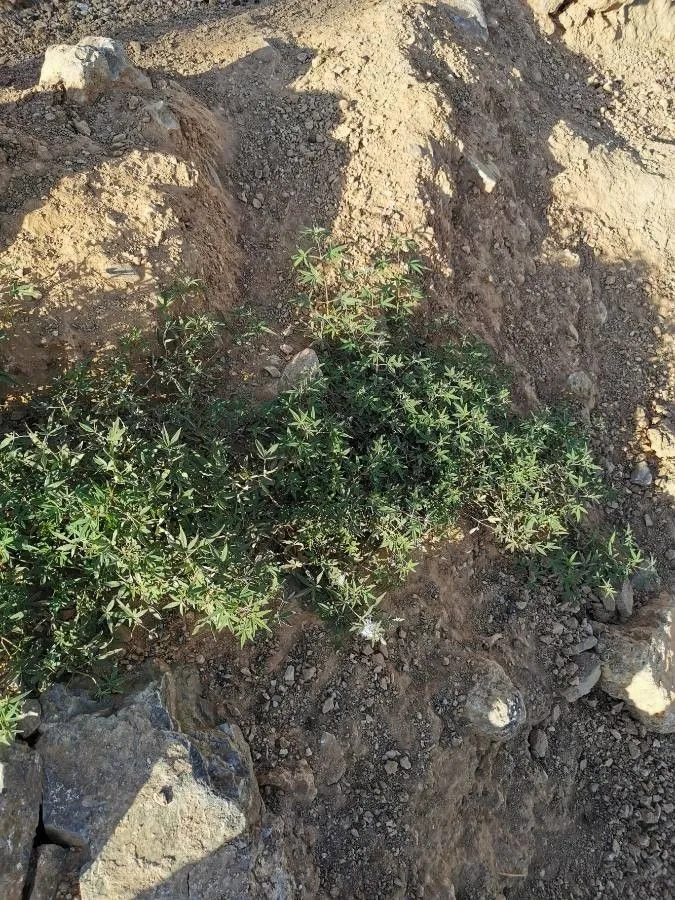
Author: L.
Bibliography: Sp. Pl.: 638 (1753)
Year: 1753
Status: accepted
Rank: species
Genus: Vitex
Vegetable: False
Observations: Medit. to C. Asia and Pakistan
Chasteberry, scientifically known as Vitex agnus-castus, is a deciduous shrub belonging to the family Lamiaceae. Originating from the Mediterranean region, Central Asia, and parts of Pakistan, this plant has long held a revered place in traditional herbal medicine and modern horticulture alike.
Characterized by its striking, aromatic leaves and gorgeous lilac to violet flowers, Chasteberry is not just visually pleasing but also highly valued for its medicinal properties. The plant typically thrives in warm, temperate climates and can be seen adorning gardens and landscapes with its lush, bushy appearance, which can reach heights of up to 4-6 feet.
The famed Chasteberry fruit has been utilized for centuries, most notably in ancient Greek and Roman societies, where it was thought to have beneficial effects on hormonal balance. Historically, it was believed to promote chastity, hence the name “Chasteberry.” Traditional uses primarily focused on women’s health, particularly for alleviating symptoms of premenstrual syndrome (PMS), regulating menstrual cycles, and addressing menopause-related discomfort.
Modern research supports some of these historical uses, with studies indicating that Vitex agnus-castus can positively influence hormonal activity, making it a popular supplement in the domain of natural health. The active compounds, such as flavonoids, iridoid glycosides, and essential oils, are thought to interact with the pituitary gland, helping to normalize the balance of estrogen and progesterone.
Culturally and medicinally significant, Chasteberry also finds application in the culinary world, albeit less commonly. The berries can be dried and used as a spice, imparting a peppery flavor that complements a variety of dishes.
Cultivation of Chasteberry requires well-drained soil and plenty of sunlight. It is a highly adaptable plant that, once established, requires minimal maintenance and is relatively drought-resistant. For gardeners seeking a resilient yet attractive addition to their flora, Chasteberry offers both aesthetic appeal and herbal utility.
In conclusion, Vitex agnus-castus, or Chasteberry, stands out not only for its beautiful appearance and adaptable nature but also for its rich history and continued relevance in herbal medicine. This multifaceted plant continues to be a treasured component of both gardens and natural health repertoires.
Eng: lilac chastetree, chasteberry, chastetree, chaste tree, monk’s pepper
Deu: mönchspfeffer
Por: angola
Fra: arbre chaste, gattilier
Swe: kyskhetsträd
En: Chasteberry, Chastetree, Lilac chastetree, Chaste Tree, Monk’s Pepper, Abraham’s-bush, Agnus-castus, Hemp Tree, Vitex, Abraham’s balm, Agnus castus, Hemptree, Monks’ Pepper Tree
Ar: Fitex, Ghar bari asraq, Kaf marim, Ibrahim, Kaf mariyam, Shajarat, كف مريم
Ca: Agnocast, Alís, Aloc, Arbre de sant Josep, Pebre bord, Ximbla
Nl: Kuisheidsstruik, Monnikkenpeper
Fr: Gattilier, Arbre chaste, Arbre au poivre, Agneau-chaste, Petit Poivre, Poivre sauvage, Muguet bleu, Poivre des moines
De: Mönchspfeffer, Abrahamstrauch, Keuschbaum, Keuschlammstrauch, Abrahamsstrauch, Keuschlamm
He: שיח-אברהם מצוי
It: Agno-casto, Aino, Lágano, Agno casto, Agnocasto, Albero del pepe, Pepe falso
Pt: Angola, Árvore-da-castidade, Agno casto, Anho-casto, Flor da castidade, Pimenteiro silvestre, Árvore da castidade
Es: Agno casto, Gatillo casto, Hierba de la castidad, Sauzgatillo
Sv: Kyskhetsträd
Taken Sep 10, 2019 by Lyrismo (cc-by-sa)
Taken Jul 30, 2022 by Pépé Lemoco (cc-by-sa)
Taken Oct 5, 2017 by katia mysline (cc-by-sa)
Taken Sep 17, 2021 by Dieter Wagner (cc-by-sa)
Taken Nov 21, 2017 by Dieter Wagner (cc-by-sa)
Taken Aug 15, 2021 by huy HO (cc-by-sa)
Taken Jul 27, 2021 by Irmgard Groß (cc-by-sa)
Taken Aug 29, 2021 by Rosell Ramon (cc-by-sa)
Taken Sep 17, 2021 by Dieter Wagner (cc-by-sa)
Taken Jul 7, 2018 by José Carlos Del Villar Pareja (cc-by-sa)
© copyright of the Board of Trustees of the Royal Botanic Gardens, Kew.
© copyright of the Board of Trustees of the Royal Botanic Gardens, Kew.
© copyright of the Board of Trustees of the Royal Botanic Gardens, Kew.
Taken Sep 16, 2022 by Kai Best (cc-by-sa)
Taken Oct 1, 2021 by Jean-Marc Wiederrecht (cc-by-sa)
Taken Jul 27, 2021 by Irmgard Groß (cc-by-sa)
Taken Aug 15, 2021 by huy HO (cc-by-sa)
Taken Jul 5, 2020 by Giode Tonpino (cc-by-sa)
Taken Sep 22, 2019 by Costas Kouremenos (cc-by-sa)
Taken Sep 2, 2019 by floska (cc-by-sa)
Taken Oct 2, 2021 by Ferri Angelino (cc-by-sa)
Taken Oct 2, 2021 by Ferri Angelino (cc-by-sa)
Taken Sep 24, 2021 by Michelle Mateos (cc-by-sa)
Taken Jul 6, 2022 by Manuel Madrid (cc-by-sa)
Taken Jun 29, 2021 by Prieta Javier (cc-by-sa)
Taken Sep 11, 2021 by Simone Cappello (cc-by-sa)
Taken Aug 31, 2022 by Acosta García Isabel (cc-by-sa)
Taken Sep 22, 2019 by Costas Kouremenos (cc-by-sa)
Taken Jul 5, 2020 by Giode Tonpino (cc-by-sa)
Taken Sep 14, 2019 by Jean-Daniel BLARD (cc-by-sa)
Taken May 2, 2012 by Tela Botanica − pierre BONNET (cc-by-sa)
Taken Aug 16, 2019 by Rolf Lehmann (cc-by-sa)
Taken Aug 28, 2022 by Joan Francesc (cc-by-sa)
Growth habit: Tree, Shrub
Ph maximum: 7.5
Ph minimum: 7.0
Light: 7
Atmospheric humidity: 7
Bloom months: [‘jun’, ‘jul’, ‘aug’]
Soil nutriments: 6
Family: Myrtaceae Author: (F.Muell.) K.D.Hill & L.A.S.Johnson Bibliography: Telopea 6: 402 (1995) Year: 1995 Status:…
Family: Rubiaceae Author: Pierre ex A.Froehner Bibliography: Notizbl. Bot. Gart. Berlin-Dahlem 1: 237 (1897) Year:…
Family: Sapindaceae Author: Koidz. Bibliography: J. Coll. Sci. Imp. Univ. Tokyo 32(1): 38 (1911) Year:…
Family: Asteraceae Author: A.Gray Bibliography: Pacif. Railr. Rep.: 107 (1857) Year: 1857 Status: accepted Rank:…
Family: Fabaceae Author: Medik. Bibliography: Vorles. Churpfälz. Phys.-Ökon. Ges. 2: 398 (1787) Year: 1787 Status:…
Family: Aspleniaceae Author: (Cav.) Alston Bibliography: Bull. Misc. Inform. Kew 1932: 309 (1932) Year: 1932…